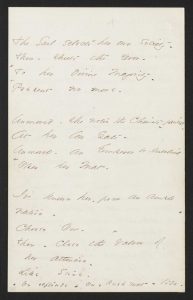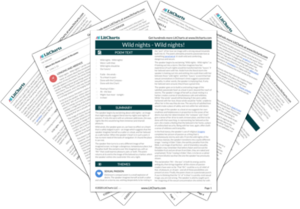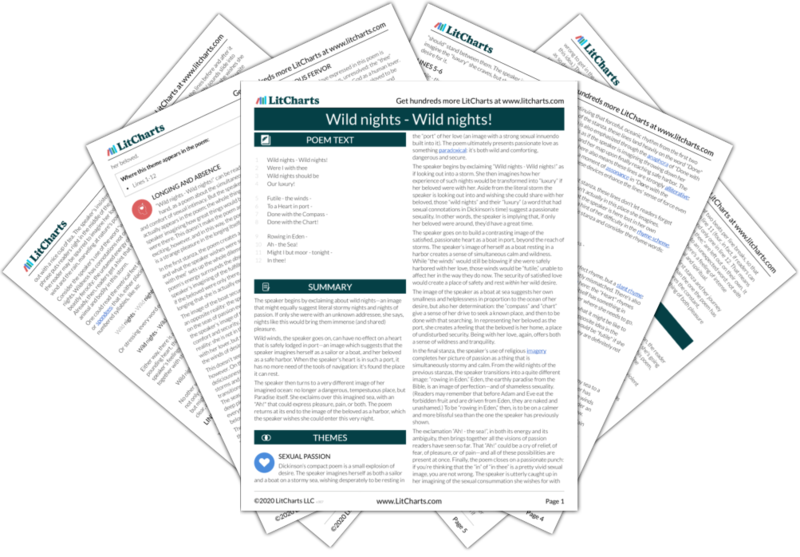
Emily Dickinson in 1862: A Weekly Blog


“The Soul selects her own Society” (F409)

The Soul selects her own Society – Then – shuts the Door – To her divine Majority – +Present no more – +Obtrude
Unmoved – she notes the Chariots – pausing – At her low Gate – Unmoved – an Emperor be kneeling + Opon her Mat – +On [her] Rush mat
I’ve known her – from an ample nation – Choose One – Then – close the – +Valves of +lids her attention – Like Stone –
Link to EDA manuscript . Originally in Packet XIII, Mixed Fasciles, ca. 1862. First published in Poems (1890), 26, from the fascicle copy ( A ), with the alternatives for lines 3 and 4 adopted. Courtesy of Houghton Library, Harvard University, Cambridge, Mass.
This is a touchstone poem about selection and choice in Dickinson’s canon and it has been read and much debated. Helen Vendler does a close reading of the poem, comparing it to “Of all the Souls that stand Create” (F 279), which, she argues, recounts in “unsurpassable” terms the soul’s “eschatological” or timeless and eternal choice of one person. Here, she thinks, Dickinson redoes the topic “in humbler terms.”
One place to start is with the form. The poem begins each stanza with long lines followed by very short ones, which sets a pattern of extension and truncation that feels like something being shut down or out. The first two stanzas begin with pentameter lines followed by short lines of dimeter (two feet each). The thirds stanza starts with a nine syllable line followed by a monometer (one foot line). Attention is getting shorter and shorter. In this last stanza, the monomter lines contaib spondees, two stressed syllables that bang shut with a double thump. Annie Finch observes that the poem
retreats from its initial iambic pentameter line, a movement that metrically parallels the poem’s verbal description of self-reliance and frugality.
The word “valves” with its variant of “lids” suggests an exclusion that resembles blindness and suffocation. The final rhyme of “One” and “Stone” reinforces the sense of rigidity, especially in how the first word is enclosed in the second.
In reading this poem, many readers invoke Emerson’s notion of self-reliance and his advocacy of retreating into the soul in search of the divine. Emily Budick suggests the poem
borrows linguistic trappings from Puritan theology and applies them to the phenomenon of Transcendentalism.
Notable is the theme of royalty in the “Chariots” that pause at the soul’s humble abode, and the “Emperor” found kneeling upon the soul’s lowly door mat. It is also important to note that in the third stanza, the speaker differentiates herself from this discerning “soul,” or speaks about herself in the third person–how discriminating!
Budick, E. Miller. “When the Soul Selects: Emily Dickinson’s Attack on New England Symbolism.” American Literature 51.3 (Nov. 1979): 349-63, 352.
Finch, A. R. C. “Dickinson and Patriarchal Meter: A Theory of Metrical Codes.” PMLA 102.2 (Mar. 1987): 166-76, 172-3.
Vendler, Helen. Dickinson: Selected Poems and Commentaries. Cambridge: Belknap Press of Harvard University, 2010, 187-190.
Back to index

- school Campus Bookshelves
- menu_book Bookshelves
- perm_media Learning Objects
- login Login
- how_to_reg Request Instructor Account
- hub Instructor Commons
- Download Page (PDF)
- Download Full Book (PDF)
- Periodic Table
- Physics Constants
- Scientific Calculator
- Reference & Cite
- Tools expand_more
- Readability
selected template will load here
This action is not available.

12.9: 409 (The Soul selects her own Society)
- Last updated
- Save as PDF
- Page ID 125868
The Soul selects her own Society — Then — shuts the Door — To her divine Majority — Present no more —
Unmoved — she notes the Chariots — pausing — At her low Gate — Unmoved — an Emperor be kneeling Upon her Mat —
I’ve known her — from an ample nation — Choose One — Then — close the Valves of her attention — Like Stone —
- Poems & Essays
- Poetry in Motion NYC
Home > Poems > The Soul selects her own Society
The Soul selects her own Society
By Emily Dickinson
The Soul selects her own Society — Then — shuts the Door — To her divine Majority — Present no more —
Unmoved — she notes the Chariots — pausing — At her low Gate — Unmoved — an Emperor be kneeling Upon her Mat —
I've known her — from an ample nation — Choose One — Then — close the Valves of her attention — Like Stone —
- National Poetry Month
- Materials for Teachers
- Literary Seminars
- American Poets Magazine
Main navigation
- Academy of American Poets
User account menu

Find and share the perfect poems.
Page submenu block
- literary seminars
- materials for teachers
- poetry near you
The Soul selects her own Society (303)
Add to anthology.
The Soul selects her own Society — Then — shuts the Door — To her divine Majority — Present no more —
Unmoved — she notes the Chariots — pausing — At her low Gate — Unmoved — an Emperor be kneeling Upon her Mat —
I've known her — from an ample nation — Choose One — Then — close the Valves of her attention — Like Stone —
This poem is in the public domain.
More by this poet
Dear march—come in—(1320).
Dear March—Come in— How glad I am— I hoped for you before— Put down your Hat— You must have walked— How out of Breath you are— Dear March, how are you, and the Rest— Did you leave Nature well— Oh March, Come right upstairs with me—
One Sister have I in our house (14)
To make a prairie (1755).
To make a prairie it takes a clover and one bee, One clover, and a bee. And revery. The revery alone will do, If bees are few.
Newsletter Sign Up
- Academy of American Poets Newsletter
- Academy of American Poets Educator Newsletter
- Teach This Poem

Wild nights - Wild nights! Summary & Analysis by Emily Dickinson
- Line-by-Line Explanation & Analysis
- Poetic Devices
- Vocabulary & References
- Form, Meter, & Rhyme Scheme
- Line-by-Line Explanations

"Wild nights - Wild nights!" is a poem by Emily Dickinson, one of the most famous and original of American writers. In this brief but powerful poem, the speaker longs to share "wild nights" with an absent lover. She imagines herself as a sailor on a stormy sea, searching for the harbor of her love. The lover in the poem might reference the speaker's desire to be closer to God, or simply the desire to be intimate with another person. On that note, when the poem was first published in an 1891 collection of Dickinson's work, the publisher worried that the poem's eroticism might shock the general public!
- Read the full text of “Wild nights - Wild nights!”

The Full Text of “Wild nights - Wild nights!”
1 Wild nights - Wild nights!
2 Were I with thee
3 Wild nights should be
4 Our luxury!
5 Futile - the winds -
6 To a Heart in port -
7 Done with the Compass -
8 Done with the Chart!
9 Rowing in Eden -
10 Ah - the Sea!
11 Might I but moor - tonight -
12 In thee!

“Wild nights - Wild nights!” Summary
“wild nights - wild nights” themes.

Sexual Passion
- See where this theme is active in the poem.

Longing and Absence

Religious Fervor
Line-by-line explanation & analysis of “wild nights - wild nights”.
Wild nights - Wild nights!

Were I with thee
Wild nights should be Our luxury!
Futile - the winds - To a Heart in port -
Done with the Compass - Done with the Chart!
Rowing in Eden - Ah - the Sea!
Lines 11-12
Might I but moor - tonight - In thee!
“Wild nights - Wild nights!” Symbols

- See where this symbol appears in the poem.

“Wild nights - Wild nights!” Poetic Devices & Figurative Language
Alliteration.
- See where this poetic device appears in the poem.
Extended Metaphor
“wild nights - wild nights” vocabulary.
Select any word below to get its definition in the context of the poem. The words are listed in the order in which they appear in the poem.
- See where this vocabulary word appears in the poem.
Form, Meter, & Rhyme Scheme of “Wild nights - Wild nights!”
Rhyme scheme, “wild nights - wild nights” speaker, “wild nights - wild nights” setting, literary and historical context of “wild nights - wild nights”, more “wild nights - wild nights” resources, external resources.
An article by Dickinson's publisher, Thomas Higginson — This 1891 article from the Atlantic is Dickinson's publisher's account of his correspondence with her and the posthumous printing of her poems.
A Short Biography of Dickinson — The Poetry Foundation's biography of Dickinson, with links to more of her poems.
Dickinson's Manuscript Copy of the Poem — The manuscript for "Wild nights - Wild nights!" in Dickinson's own handwriting.
The Emily Dickinson Museum — The official website for the Emily Dickinson museum, with further information on her life and works.
Sarah Arvio's Reading of "Wild nights - Wild nights!" — A short piece from the Poetry Society of America on a writer's first experience reading this poem (including opinions on some of the readings discussed in this guide).
LitCharts on Other Poems by Emily Dickinson
A Bird, came down the Walk
After great pain, a formal feeling comes –
A Light exists in Spring
A Murmur in the Trees—to note—
A narrow Fellow in the Grass
An awful Tempest mashed the air—
As imperceptibly as grief
A still—Volcano—Life—
Because I could not stop for Death —
Before I got my eye put out
Fame is a fickle food
Hope is the thing with feathers
I cannot live with You –
I cautious, scanned my little life
I could bring You Jewels—had I a mind to—
I did not reach Thee
I died for Beauty—but was scarce
I dreaded that first Robin, so
I dwell in Possibility –
I felt a Funeral, in my Brain
If I can stop one heart from breaking
I had been hungry, all the Years
I have a Bird in spring
I heard a Fly buzz - when I died -
I like a look of Agony
I like to see it lap the Miles
I measure every Grief I meet
I’m Nobody! Who are you?
I started Early — Took my Dog —
I taste a liquor never brewed
It was not Death, for I stood up
I—Years—had been—from Home—
Like Rain it sounded till it curved
Much Madness is divinest Sense -
My Life had stood - a Loaded Gun
Nature is what we see
One need not be a Chamber — to be Haunted
Publication — is the Auction
Safe in their Alabaster Chambers
Success is counted sweetest
Tell all the truth but tell it slant —
The Brain—is wider than the Sky—
The Bustle in a House
The Mushroom is the Elf of Plants
There came a Wind like a Bugle
There is no Frigate like a Book
There's a certain Slant of light
There's been a Death, in the Opposite House
The saddest noise, the sweetest noise
The Sky is low — the Clouds are mean
The Soul has bandaged moments
The Soul selects her own Society
The Wind – tapped like a tired Man –
They shut me up in Prose –
This is my letter to the world
This World is not Conclusion
'Twas the old—road—through pain—
We grow accustomed to the Dark
What mystery pervades a well!
Whose cheek is this?
Everything you need for every book you read.


A Summary and Analysis of Emily Dickinson’s ‘Much Madness is Divinest Sense’
By Dr Oliver Tearle (Loughborough University)
‘Much Madness Is Divinest Sense’ is the unofficial title of one of Emily Dickinson’s poems (she tended not to give her poems titles: they’re simply numbered in her Complete Poems , and this one is number 620).
The poem challenges conventional notions of sanity and madness, arguing that what society often perceives as ‘madness’ can actually be some kind of profound insight and truth, while those appearing ‘sane’ might be deeply misled. Indeed, what society calls ‘madness’ in some may even be some sort of divine insight, or ‘sense’.
Much Madness is divinest Sense – To a discerning Eye – Much Sense – the starkest Madness – ’Tis the Majority In this, as all, prevail – Assent – and you are sane – Demur – you’re straightway dangerous – And handled with a Chain –
To paraphrase Dickinson’s short poem: to a perceptive person, what appears to be ‘madness’ or insanity in another is actually good sense, divinely inspired. Conversely, what many people assume to be common sense is, in reality, unadulterated madness.
It’s the general consensus among society which determines what is called ‘madness’ and what is deemed ‘sanity’: if you ‘assent’ or agree with the mainstream view in a particular society, you are considered sane, but if you ‘demur’ or object, you’re immediately viewed as dangerously mad, in need to being restrained with a metal chain for your own, and other’s, safety.
This is a loose paraphrase of Dickinson’s little poem, to serve as a ‘way in’ to understanding its core meaning. But what else needs to be said? For a start, how did she come to write such a poem, and hold such views?
In one of her letters, Emily Dickinson wrote: ‘Had we the first intimation of the Definition of Life, the calmest of us would be Lunatics!’ Dickinson’s poem is interested not just in worldly sanity (or insanity) but in ideas of the divine, or religious. If any of us had a glimpse of the divine and discovered the real reason we’re all here on earth, the revelation would be enough to render even the sanest and calmest of us a babbling madman (or madwoman).
Dickinson’s poem is, of course, concerned with a reversal of normality: ‘Much Madness’, she begins by asserting, is actually – contrary to popular belief ‘divinest Sense.’ Not all madness, we should note, but ‘much’, nevertheless. For every random person who is merely mentally unwell and in need of help and sympathy, there may also be a William Blake, or some other visionary who was denounced as a ‘lunatic’ because their insights and work were barely understood by their contemporaries.
In other words, contrary to societal expectations, we should keep in mind that what is considered mad might hold deeper meaning than what appears normal. And the flipside of this is that behaviour or attitudes which might appear ‘normal’ and perfectly sane may actually be madness, but the insanity of such behaviours and ideas are hidden from people because the majority holds them.
Consider some of the views which people of a century or so ago held. Eugenics was, for a long time in the early twentieth century, enthusiastically endorsed by many prominent intellectuals and thinkers, who believed that all of humankind could be improved with a little cleansing of the gene pool.
Nowadays, the mainstream view is that eugenics is an abhorrent practice and an unacceptable infringement on an individual’s right to have children. We take such a view for granted, but a hundred years ago, many leading thinkers would look at you as if you were mad for saying such a thing.
Similarly, two hundred years ago, the idea that women should have equal voting rights to men was a fringe notion in many countries. In Britain, even the Chartists campaigned for electoral reform for men alone, rather than women. Nowadays, it’s people who object to equal suffrage for the two sexes who are considered the irrational ones.
The point, then, is that societies decide which views are considered ‘mad’ and which are ‘sane’, but societies can be wrong. It’s the majority that decides, but there’s a well-known logical fallacy, argumentum ad populum (Latin for ‘appeal to the people’), which revolves around claiming something is true or morally good because many people think it is. Two centuries ago, many people in Britain and the US believed slavery was a good thing. How many people in the twenty-first century believe it is?
This phenomenon was already well-known in the nineteenth century, when Dickinson (1830-86) was writing. Charles Mackay’s Extraordinary Popular Delusions and the Madness of Crowds , published in 1841, had explored how many manias of the past – from Tulip mania to the South Sea Bubble to the Crusades – were regarded as perfectly rational pursuits, or beliefs, when they happened.
The Tyranny of the Mob
The speaker of Dickinson’s poem highlights that divine inspiration from God often comes to those perceived as mad; she implies that these individuals possess a unique, divinely-inspired understanding. However, society fails to recognize their genius, instead labelling them ‘starkest Madness’.
If this were all the poem said, however, the sentiment would be unremarkable. What gives ‘Much Madness Is Divinest Sense’ its acute psychological edge – its ‘bite’, we might say, or even its social commentary – is the closing image of the ‘demurrer’ being bound in chains for merely voicing opposition to the beliefs of the crowd.
As Helen Vendler points out in her study of Dickinson’s poetry, Dickinson , ‘demur’ is a mild verb which means voicing the gentlest opposition to something. It is not vehement rejection or resistance, but, we might say, a simple case of saying, ‘But surely …’ or ‘But what about …’
For this offence, the demurrer is proclaimed ‘mad’ and restrained in the most objectionable way. What else, we may wonder, does the bullying mob plan to do with that individual once they have him or her chained? As Vendler argues, the Dickinson’s ‘protest is against the Majority’s vehement conviction that a demurral to its views is so dangerous that it must be repressed, censored, or bestially punished.’
So Dickinson’s poem criticises the majority, not just for lacking the insight that a handful of rare visionaries have into what is true and what is not, but for treating those who do possess that insight both cruelly and unfairly, feeling confident that they are in the right because they outnumber the individual demurrer.
The poem’s unconventional use of capitalisation, dashes, and slant rhyme reflects Dickinson’s unique style and adds to the poem’s enigmatic nature. The metre is largely iambic:
Much MAD-ness IS di-VIN-est SENSE – To A dis-CERN-ing EYE –
It might be worth reading this prose poem from the twentieth-century Lebanese-American poet Kahlil Gibran alongside Dickinson’s, since its message – if that is the word – chimes in some ways with the meaning found in this poem.
Discover more from Interesting Literature
Subscribe now to keep reading and get access to the full archive.
Type your email…
Continue reading

IMAGES
VIDEO
COMMENTS
Emily Dickinson's "The Soul selects her own Society" was first published posthumously in 1890, long after Dickinson wrote the poem in 1862. In this poem, the speaker celebrates the virtues of an independent and mostly solitary life. The speaker envisions her soul as a queenly figure who chooses her company carefully, without regard for worldly ...
Poem Analyzed by Emma Baldwin. B.A. English (Minor: Creative Writing), B.F.A. Fine Art, B.A. Art Histories. 'The Soul selects her own Society'. The Soul selects her own Society Emily Dickinson. The Soul selects her own Society — Then — shuts the Door — To her divine Majority — Present no more —. Unmoved — she notes the Chariots ...
Helen Vendler does a close reading of the poem, comparing it to "Of all the Souls that stand Create" (F 279), which, she argues, recounts in "unsurpassable" terms the soul's "eschatological" or timeless and eternal choice of one person. Here, she thinks, Dickinson redoes the topic "in humbler terms.". One place to start is ...
Oct 10, 2023 6:43 PM EDT. Emily Dickinson. Emily Dickinson and a Summary of "The Soul selects her own Society" (Fr409) "The Soul selects her own Society" is one of Emily Dickinson's 'soul' poems in which she explores inner needs and self-reliance. In effect, these poems are about identity. They are snippets of self-analysis that help the reader ...
A summary of "The Soul selects her own Society—" in Emily Dickinson's Dickinson's Poetry. Learn exactly what happened in this chapter, scene, or section of Dickinson's Poetry and what it means. Perfect for acing essays, tests, and quizzes, as well as for writing lesson plans.
Get LitCharts A +. "The Brain—is wider than the Sky—" was written by the 19th-century American poet Emily Dickinson. In the poem, the speaker praises the human mind's capacity to imagine, perceive, and create, ultimately suggesting that the mind is boundless in its potential—and that this boundlessness links humanity to God.
Unmoved — she notes the Chariots — pausing —. At her low Gate —. Unmoved — an Emperor be kneeling. Upon her Mat —. I've known her — from an ample nation —. Choose One —. Then — close the Valves of her attention —. Like Stone —. 12.9: 409 (The Soul selects her own Society) is shared under a not declared license and was ...
The Soul selects her own Society —. Then — shuts the Door —. To her divine Majority —. Present no more —. Unmoved — she notes the Chariots — pausing —. At her low Gate —. Unmoved — an Emperor be kneeling. Upon her Mat —. I've known her — from an ample nation —.
Emily Dickinson remained single throughout her life, so the persona in the poem is an invented one. ... 409. To be alive—is Power (677) 410. To fight aloud, is very brave (126)
Full Book Analysis. Emily Dickinson is such a unique poet that it is very difficult to place her in any single tradition—she seems to come from everywhere and nowhere at once. Her poetic form, with her customary four-line stanzas, ABCB rhyme schemes, and alternations in iambic meter between tetrameter and trimeter, is derived from Psalms and ...
A collection of her works, Poems by Emily Dickinson, of the American poet Emily Dickinson edited by Mabel Loomis Todd and Thomas Wentworth Higginson. It was first published in 1890 by Roberts Brothers publishing house. Dickinson's poems explore themes of nature, death, and love. Her unique voice and unconventional style make her a seminal ...
The title of Dickinson's poem 'Some keep the Sabbath going to Church -' is the very first line of the first stanza. Readers are aware of the fact that most of her poems are written without a title. The editors later included the title while publishing Emily Dickinson's poems after her death. They also struggled to find apt titles.
Emily Dickinson 409 Analysis. Decent Essays. 728 Words. 3 Pages. Open Document. Emily Dickinson is one of the most influential figures in American literature. Her unusual character and style has made her become one of America's best and most original poets of all time. She composed almost 1800 poems, but fewer than a dozen were published in ...
My Life had stood - a Loaded Gun. 'My Life had stood - a Loaded Gun' by Emily Dickinson is a complex, metaphorical poem. The poet depicts a woman who is under a man's control and sleeps like a load gun. The gun is a powerful and moving image in this poem that has made the text one of Dickinson's most commonly studied.
Emily Dickinson Poetry: American Poets Analysis. During her lifetime, only seven of Emily Dickinson's poems were published, most of them edited to make them more conventional. After Dickinson ...
The American poet Emily Dickinson wrote "After great pain, a formal feeling comes" around 1862. Like many of Dickinson's poems from this period, "After great pain" discusses the experience of emotional suffering—specifically, the numb paralysis that the speaker says follows intense shock or trauma. The poem's form, which is alternately ...
Emily Dickinson's poetry is undeniably original in its subject matter while also pushing the boundaries of what can be considered poetry, abandoning traditional restraints and conventional topics ...
Unmoved — an Emperor be kneeling. Upon her Mat —. I've known her — from an ample nation —. Choose One —. Then — close the Valves of her attention —. Like Stone —. c. 1862. This poem is in the public domain. The Soul selects her own Society (303) - The Soul selects her own Society—.
A summary of a classic Dickinson poem by Dr Oliver Tearle 'One need not be a Chamber - to be Haunted'. So begins one of Emily Dickinson's most striking poems. This poem requires close analysis because it presents an interesting nineteenth-century example of the internalisation of 'spirits' and the notion of 'haunting'. One need not…
A brief summary of the poem quickly reveals how odd it is, even by Emily Dickinson's wonderfully eccentric standards. But then 'I felt a Funeral, in my Brain' is about going mad, about losing one's grip on reality and feeling sanity slide away - at least, in one interpretation or analysis of the poem. In the first stanza, the poem's speaker uses the metaphor of the funeral for what ...
is a poem by Emily Dickinson, one of the most famous and original of American writers. In this brief but powerful poem, the speaker longs to share "wild nights" with an absent lover. She imagines herself as a sailor on a stormy sea, searching for the harbor of her love. The lover in the poem might reference the speaker's desire to be closer to ...
A summary of a classic Dickinson poem by Dr Oliver Tearle. 'Pain — has an Element of Blank - ' is a short poem by Emily Dickinson which, like 'It was not Death, for I stood up', treats the dark subject of mental and physical pain and the way it engulfs our lives, extinguishing everything else. Pain — has an Element of Blank ...
By Dr Oliver Tearle (Loughborough University) 'Much Madness Is Divinest Sense' is the unofficial title of one of Emily Dickinson's poems (she tended not to give her poems titles: they're simply numbered in her Complete Poems, and this one is number 620).. The poem challenges conventional notions of sanity and madness, arguing that what society often perceives as 'madness' can ...